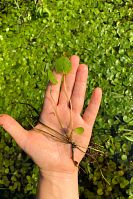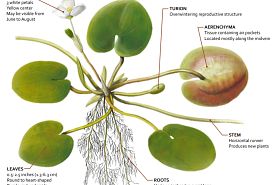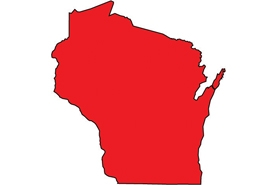European frog-bit
(Hydrocharis morsus-ranae)
 Photo credit: Wisconsin DNR, Amanda Smith
Photo credit: Wisconsin DNR, Amanda SmithEuropean frog-bit is a free-floating aquatic plant native to Europe and northeastern Asia. It was first introduced to North America in the 1930s as an ornamental plant and started to spread throughout the Great Lakes region in the 1970s. In Wisconsin, European frog-bit was first documented in 2021 in the coastal areas of Marinette and Oconto counties along Green Bay. It primarily reproduces through stolons (stems that branch out from the main plant to form new plants) and turions (overwintering buds).
Other names for this plant include:
- Common names: common frogbit, European frog’s-bit
Classification in Wisconsin: Prohibited
Ecological and Socio-economic Impacts
- In some waterbodies, particularly calm or slow-moving waterbodies, European frog-bit can form large vegetation mats that can impede recreational activities, like fishing, boating, and swimming.
- These large mats of European frog-bit can prevent light from reaching the water column and deplete dissolved oxygen levels, which may negatively affect native aquatic plants and wildlife.
Identification
Leaves: Round to heart-shaped and ½ to 2 ½ inches across. The undersides of leaves have a spongy texture and can be dark purple, red, or green in color.
Flowers: Small (¾ to 1 ¼ inch), white with 3 petals and a yellow center.
Reproductive structures: Stolons are cord-like and may have small turions attached. A single European frog-bit can produce approximately 100 to 150 turions.
Roots: Unbranched and up to 12 inches long. Roots are generally unanchored to sediment.
Similar species: European frog-bit resembles several native floating-leaf species, including native waterlilies (Nuphar spp. and Nymphaea spp.) and watershield (Brasenia schreberi).
Distribution
See the reported locations of European frog-bit in Wisconsin.
Do you know of other populations? Please send us a report.
Control

Prevention: The best way to keep a lake free of European frog-bit is to prevent its establishment. Wisconsin's invasive species law prohibits the transport of aquatic plants, live animals and water from a waterbody, with some exceptions for bait.
- Before leaving the boat launch, conduct the following actions required by law:
- Inspect and remove aquatic plants and animals from boats and equipment.
- Drain all water from the boat and equipment.
- Before entering another waterbody:
- Spray boat and equipment with high-pressure hot water, or
- Allow the boat and equipment to dry out of water for at least five days.
Mechanical & Chemical: There is currently very little research on the efficacy of mechanical and chemical control on European frog-bit populations. Manual removal may help remove small, isolated populations.
The Wisconsin European Frog-bit Response Team, comprised of state and local agencies and partners, is responsible for coordinating the response to the recently discovered European frog-bit populations in Green Bay coastal areas. The Response Team has been using a combination of chemical and mechanical control methods as part of an Integrated Pest Management (IPM) strategy. It is implementing pre- and post-treatment monitoring to evaluate the efficacy of these methods.
- Before leaving the boat launch, conduct the following actions required by law:
Resources
Links for more information:
- Wisconsin European Frog-bit Response Team 2022 Annual Report and 2023 Plan
- European Frog-bit (Hydrocharis morsus-ranae) A Technical Review of Distribution, Ecology, Impacts, and Management
- European Frog-bit, USGS Nonindigenous Aquatic Species Database
- European Frog-bit Collaborative, Great Lakes Commission


